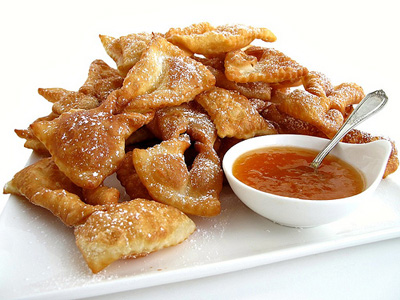 As a kid, I always wondered why we never celebrated Halloween. Only as an adult did I come to realize that it's really just an American holiday. So, I thought to myself, when do Hungarian kids get a chance to dress up and be whomever they wish to be for one day? The answer is Carnival. I never got dressed up for the holiday, but in Hungary my little nephews always did for school. But never mind all those Mardi Gras celebrations, for me, the best part about Carnival are the doughnuts. Crispy, fluffy, and airy doughnuts!
As a kid, I always wondered why we never celebrated Halloween. Only as an adult did I come to realize that it's really just an American holiday. So, I thought to myself, when do Hungarian kids get a chance to dress up and be whomever they wish to be for one day? The answer is Carnival. I never got dressed up for the holiday, but in Hungary my little nephews always did for school. But never mind all those Mardi Gras celebrations, for me, the best part about Carnival are the doughnuts. Crispy, fluffy, and airy doughnuts!
A few years ago I had a quest to find the best beignets in New York City. I tried the dessert at countless restaurants only to discover leaden balls and soggy balls. I thought I'd never find the airy beignets I had been desperately seeking. That was until a lunch at The Modern. Run by Alsatian chef Gabriel Kreuther in the Museum of Modern Art, the restaurant has some of the best food in the city. The beignets I had for dessert were the crispiest and fluffiest doughnuts on earth. Ever since then I've been wanting to make beignets at home. So for Mardi Gras this year I took the opportunity to do just that.
My version of the classic Carnival treat is a cross between traditional beignets and what most Italians would recognize as cenci. In Hungary these doughnuts are called csöröge or forgácsfánk. The recipe uses yeast instead of the more typical baking powder to get the dough to rise. Not only does this create a puffier pastry, it's also lighter and crisper. It only takes 30 minutes to let the dough rise, so it's quicker than making traditional doughnuts—when I have a craving I don't want to wait for hours upon hours. You'll love these beignets dusted with powdered sugar and served with some preserves.
Beignet Bowties
This recipe is adapted from a Hungarian food magazine clipping.
9 ounces all-purpose flour
1/2 teaspoon salt
1/2 cup warm milk (130 degrees F.)
2 tablespoons sugar
1 envelope yeast
2 egg yolks
3 tablespoons melted butter
1/4 cup sour cream
2 tablespoons rum
vegetable oil, for frying
confectioners sugar, for dusting
apricot preserves, for serving
In a large bowl, whisk together flour and salt. Combine milk and sugar in a small bowl, stirring until sugar is mostly dissolved. Stir in yeast and allow to proof. Add to bowl with flour. Add egg yolks, butter, sour cream, and rum. Using a wooden spoon or your hands, mix until combined. Knead a little until a smooth ball of dough forms. Transfer to a floured bowl, cover with a towel, and allow to proof in a warm place for about 30 minutes.
Turn dough out onto a floured work surface. Cut into 3 manageable pieces. Working with one piece at a time, knead a little to ensure dough is resilient and no longer sticky. Roll to a thickness of 1/8 inch. Using a scalloped pastry cutter, cut into 2-1/2-inch by 6-inch rectangles. Using a sharp knife cut a slit in the center of each rectangle. Pull one side of the rectangle through the slit to create a bowtie. Edge scraps can be rerolled.
Heat about 2 inches of oil in a large skillet to 365 degrees F. Fry beignets in batches until golden brown, about 2 to 3 minutes per side. Remove to a tray lined with paper towels. Dust with confectioners sugar. Serve with apricot preserves. Yield: about 30 or more beignets.
Joseph Erdos is a New York–based writer and editor, butabove all a gastronomer and oenophile. He shares his passion for foodon his blog, Gastronomer's Guide , which features unique recipes and restaurant reviews among many other musings on the all-encompassing topic of food.


